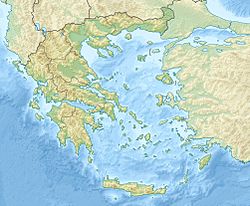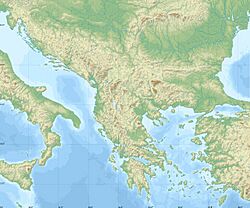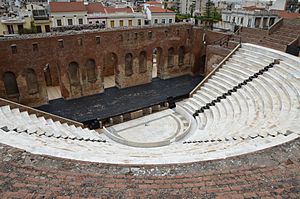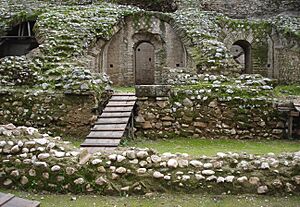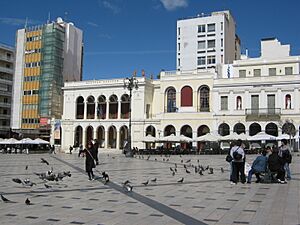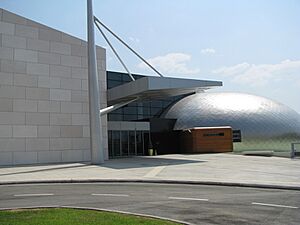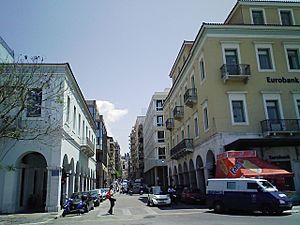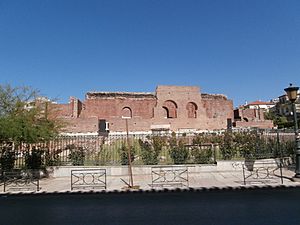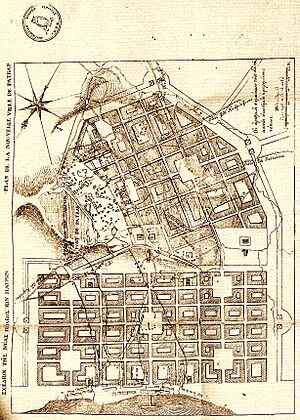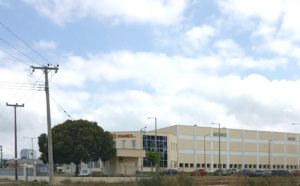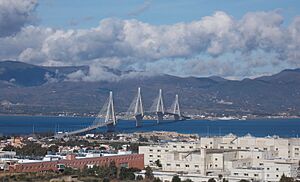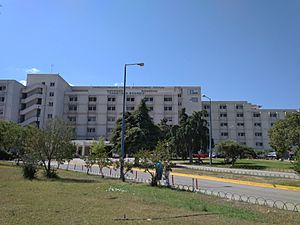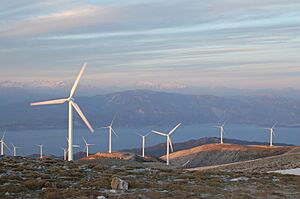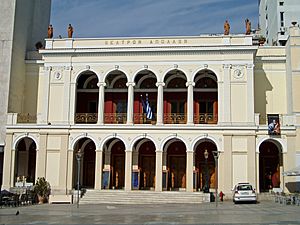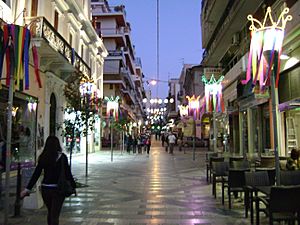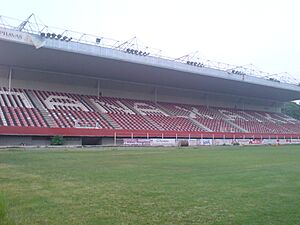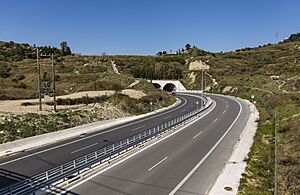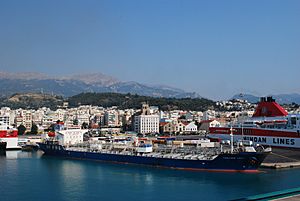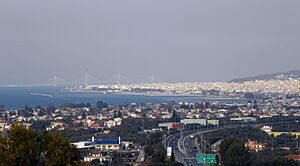Patras facts for kids
Patras (pronounced PAH-tras) is Greece's third-largest city. It's the main city in the Western Greece region, located in the northern part of the Peloponnese peninsula. Patras is about 215 kilometers (134 miles) west of Athens. The city sits at the base of Mount Panachaikon, looking out over the Gulf of Patras.
As of 2021, the city of Patras has a population of about 215,922 people. This area has been settled for over 4,000 years! During the Roman times, it was a busy international center in the eastern Mediterranean. Christian stories say that Saint Andrew, an important saint, was martyred here.
Patras is often called Greece's "Gate to the West." It's a major business center, and its busy port is a key link for trade and travel with Italy and other parts of Western Europe. The city has three public universities, which means lots of students live here. This makes Patras an important place for science and technology education. The amazing Rio-Antirio Bridge connects Patras' eastern suburb of Rio to the town of Antirrio, linking the Peloponnese peninsula to mainland Greece.
Every year in February, Patras hosts one of Europe's biggest carnivals. The Patras Carnival is famous for its huge, funny parade floats and lively parties. Hundreds of thousands of visitors enjoy the celebrations in the city's sunny Mediterranean climate. Patras is also known for its local culture, especially in performing arts and modern writing. It was even named the European Capital of Culture in 2006.
Quick facts for kids
Patras
Πάτρα
|
|||
|---|---|---|---|
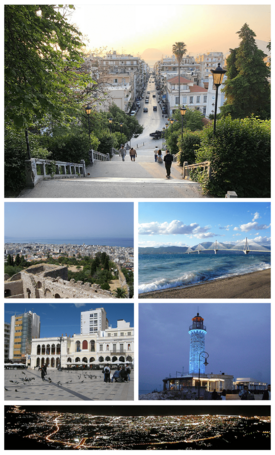 Clockwise from top: Panoramic view of downtown Ethnikis Antistaseos Square area from Agiou Nikolaou Stairs, Rio-Antirio Bridge and Gulf of Corinth, Lighthouse of Patras, Night view of Patras from Romanos Mona Forest Park, Apollon Theatre and Georgiou I Square, Castle of Patras.
|
|||
|
|||
| Country | |||
| Geographic region | Peloponnese | ||
| Administrative region | Western Greece | ||
| Regional unit | Achaia | ||
| Districts | 5 | ||
| Government | |||
| • Type | Mayor–council government | ||
| Area | |||
| • Municipality | 334.9 km2 (129.3 sq mi) | ||
| • Urban | 125.4 km2 (48.4 sq mi) | ||
| Highest elevation | 10 m (30 ft) | ||
| Lowest elevation | 0 m (0 ft) | ||
| Population
(2021)
|
|||
| • Municipality | 215,922 | ||
| • Urban | 173,600 | ||
| • Urban density | 1,384.4/km2 (3,585.5/sq mi) | ||
| • Metro | 305,979 | ||
| Demonym(s) | Patrinos (Greek: Πατρινός) | ||
| Time zone | UTC+2 (EET) | ||
| • Summer (DST) | UTC+3 (EEST) | ||
| Postal codes |
26x xx
|
||
| Telephone | 261 | ||
| Vehicle registration | ΑXx, ΑZx, AOx, AYx | ||
| Patron saint | Saint Andrew (30 November) | ||
| Website | www.e-patras.gr | ||
Contents
- Patras Through Time: A Brief History
- Exploring Patras: City Layout and Landmarks
- Patras' Natural Surroundings: Geography and Climate
- People of Patras: Demographics and Life
- Patras' Economy: How the City Works
- Culture in Patras: Arts, Festivals, and Sports
- Getting Around Patras: Transport Links
- Patras and the World: International Connections
- Images for kids
- See also
Patras Through Time: A Brief History
Early Years and Medieval Times
In 1205, Patras was taken over by William of Champlitte and Villehardouin. It became part of the Principality of Achaea. Later, in 1408, the city was controlled by Venice. But in 1430, Constantine Palaiologos took it back for the Byzantine Empire.
Patras remained part of the Despotate of Morea until 1458. That's when the Ottoman Sultan Mehmet II conquered it. Under the Ottomans, it was called "Baliabadra." This name came from "Old Patras" in Greek. Even with special privileges, it wasn't a huge trade center. Venice and Genoa tried to capture it many times. They only ruled effectively for a short time from 1687 to 1715.
In 1772, a naval battle happened near the city. It was fought between Russian and Ottoman forces.
Modern Patras: From Revolution to Today
Patras was one of the first cities where the Greek Revolution started in 1821. The Ottoman soldiers in the castle held out until 1828. After the war, much of the city was destroyed. A new city plan was created by Stamatis Voulgaris.
Patras quickly grew into Greece's second-largest city in the late 1800s. It was a major port for exporting farm products from the Peloponnese. In the early 1900s, Patras developed fast. It was the first Greek city to have public streetlights and electric trams.
World War I slowed the city's growth. After 1922, many people moved here from Asia Minor. This caused the city to grow quickly and sometimes without much planning. During World War II, Patras was bombed by Italian planes. German and Italian troops were stationed there. After the war in 1944, the city recovered. However, Athens became a much larger city over time. Since 2014, Kostas Peletidis has been the mayor.
Exploring Patras: City Layout and Landmarks
The city has two main parts: an upper section and a lower section. Roads and wide stairs connect them. The upper section, called Ano Poli, is older and more charming. The lower section, Kato Poli, was planned in 1858. It has many squares.
Two famous squares are Psila Alonia and Georgiou I Square. You can see many beautiful neoclassical buildings here. These include the Apollon Theatre and the City Hall. A replica of the old Patras Lighthouse, a city symbol, stands near the Saint Andreas temple.
Much of Patras' coastline has roads and avenues running along it. These include Dymaion Coast in the south and Iroon Polytechneiou Street in the north.
Main Sights: What to See in Patras
Patras and its area have many ancient Greek, Roman, and Byzantine monuments. These include the Roman Odeon and the castles of Rio and Patras. Here are some of the main sights:
- The Patras Archaeological Museum shows off ancient finds. These range from the Mycenaean to the Late Roman times. The museum is in a modern building designed by Theophanis Bobotis.
- The Mycenaean cemetery of Voudeni (Skioessa) is 8 kilometers (5 miles) from Patras. It's an important Mycenaean site. It was used for almost 500 years (1500–1000 BC).
- The Roman Odeon is the most important ancient monument. It's in the upper town and was built around 160 AD. It has been restored and is used for outdoor performances in summer.
- The Roman Amphitheatre is near the Roman Odeon. It dates from the 1st century AD. Only parts of it have been dug up.
- The Roman aqueduct brought water from springs to the acropolis. It was 6.5 kilometers (4 miles) long. Parts of its archways still stand today. Other Roman ruins include the stadium and a bridge over the Kallinaos river.
- The medieval Patras Castle sits on the ancient acropolis, overlooking the city. It was first built in the 6th century AD by Emperor Justinian. It was added to by the Franks, Venetians, and Ottomans. Today, you can visit it, and its inside is a public garden.
- The Orthodox Church of Saint Andrew of Patras was started in 1908. It was finished in 1974. It is dedicated to Saint Andrew, the city's patron saint. It holds relics of the saint where he was crucified. It's the second-largest Byzantine-style church in the Balkans.
- The municipal Theatre Apollon was built in 1872. It was designed by Ernst Ziller. This building is a great example of 19th-century neoclassical style. It's in the city's central square.
- The Achaia Clauss wine factory and tasting center is in Petroto village. It was founded in 1861 by Gustav Clauss. It's famous for its Mavrodaphne wine. This place also has the oldest wine in Greece, a Mavrodaphne from 1873.
- The home of Kostis Palamas is a preserved neoclassical building. The poet Kostis Palamas and painter Matilde Serao were born here.
- The Patras Lighthouse is a reconstructed landmark of the city.
- The Agiou Nikolaou Stairs, Gerokostopoulou Stairs, Patreos Stairs, and Trion Navarchon Stairs are grand outdoor staircases. They connect the upper town with the downtown area.
- The Rio–Antirrio Bridge is a modern landmark. It's one of the world's longest cable-stayed bridges.
Parks and Squares: Green Spaces in Patras
- Georgiou I Square is the main square and the heart of the city. It's named after King George I. It's always been the center of political and cultural life. It hosts all major events, especially the carnival.
- Ethnikis Antistaseos ("National Resistance Square") is another important square.
- Trion Symmachon Square is named after the three Allied Powers from the Battle of Navarino. It has a flower clock.
- Psilalonia Square is one of Patras' most popular squares. It's about 1.5 kilometers (1 mile) from downtown. It has a fountain, palm trees, and playgrounds. A statue of Germanos of Patras stands here.
- Saint George Square has a monument to the 1821 fighters. It shows the "declaration of the revolutionaries of Patras."
- The Spinney of Patras (Dasyllio) is on a pine-covered hill. It's called "the Gulf of Patras' veranda" because of its amazing views. It's great for walks and jogging.
- South Park of Patras is a nice park by the sea.
Architecture: Buildings of Patras
Patras is a relatively new city in terms of its buildings. Most medieval buildings were destroyed during the Greek War of Independence. The oldest buildings still standing (besides ancient monuments and the castle) are the church of Pantocrator and Tzini's house, built in 1832.
The area south of the castle, around the Roman Odeon, is called the Upper Town (Ano Poli). It's very appealing because buildings here are limited to two stories. This keeps its historic feel.
Districts and Neighborhoods: Parts of Patras
Today, the areas of Rio, Paralia, Messatida, and Vrachnaiika have become part of the larger Patras city area. Some main districts within Patras include:
- Agyia (north)
- Agia Sofia (north)
- Aroi (east)
- Ities (south)
- Koukouli (east)
- Neo Souli (east)
- Perivola (east)
- Prosfygika (east)
- Psarofai (east)
- Zavlani (north)
Patras' Natural Surroundings: Geography and Climate
Patras is located 215 kilometers (134 miles) west of Athens. It's 94 kilometers (58 miles) northeast of Pyrgos and 7 kilometers (4 miles) south of Rio.
The city is divided into upper and lower sections. The lower section (Kato Poli) is by the sea. It includes the city center and the port. The older upper section (Ano Poli) is around the Fortress. It's on the last hill of Mount Panachaikon before the Gulf of Patras.
Waterways: Rivers and Streams
The biggest river in the area is the Glafkos. It flows south of Patras. Its water is collected in a small dam. Since 1925, this water has been used to power Greece's first hydroelectric plant. Other smaller streams include Charadros, Meilichos, and Kallinaos.
Weather: Patras' Climate
Patras has a hot-summer Mediterranean climate. This means it has mild, wet winters and hot, dry summers. Spring and autumn are pleasant in between. Autumn is usually wetter than spring. Snowfall is rare in the city but more common in the surrounding mountains.
| Climate data for Patras Port (2008-2024) | |||||||||||||
|---|---|---|---|---|---|---|---|---|---|---|---|---|---|
| Month | Jan | Feb | Mar | Apr | May | Jun | Jul | Aug | Sep | Oct | Nov | Dec | Year |
| Record high °C (°F) | 24.9 (76.8) |
25.6 (78.1) |
25.1 (77.2) |
32.0 (89.6) |
37.2 (99.0) |
38.9 (102.0) |
40.5 (104.9) |
40.7 (105.3) |
35.7 (96.3) |
30.6 (87.1) |
28.1 (82.6) |
26.8 (80.2) |
40.7 (105.3) |
| Mean daily maximum °C (°F) | 14.1 (57.4) |
14.9 (58.8) |
16.2 (61.2) |
19.4 (66.9) |
23.0 (73.4) |
27.1 (80.8) |
30.2 (86.4) |
31.4 (88.5) |
27.4 (81.3) |
23.4 (74.1) |
19.8 (67.6) |
16.0 (60.8) |
21.9 (71.4) |
| Daily mean °C (°F) | 11.7 (53.1) |
12.4 (54.3) |
13.7 (56.7) |
16.7 (62.1) |
20.3 (68.5) |
24.3 (75.7) |
27.3 (81.1) |
28.3 (82.9) |
24.8 (76.6) |
20.7 (69.3) |
17.2 (63.0) |
13.6 (56.5) |
19.2 (66.6) |
| Mean daily minimum °C (°F) | 9.3 (48.7) |
9.9 (49.8) |
11.1 (52.0) |
14.0 (57.2) |
17.6 (63.7) |
21.5 (70.7) |
24.3 (75.7) |
25.1 (77.2) |
22.2 (72.0) |
17.9 (64.2) |
14.6 (58.3) |
11.2 (52.2) |
16.6 (61.8) |
| Record low °C (°F) | 1.2 (34.2) |
−0.9 (30.4) |
2.3 (36.1) |
8.2 (46.8) |
11.9 (53.4) |
15.0 (59.0) |
19.3 (66.7) |
20.1 (68.2) |
15.8 (60.4) |
9.2 (48.6) |
7.4 (45.3) |
3.0 (37.4) |
−0.9 (30.4) |
| Average rainfall mm (inches) | 109.5 (4.31) |
67.9 (2.67) |
71.2 (2.80) |
36.9 (1.45) |
23.5 (0.93) |
16.5 (0.65) |
5.3 (0.21) |
7.0 (0.28) |
39.6 (1.56) |
89.2 (3.51) |
109.8 (4.32) |
115.2 (4.54) |
691.6 (27.23) |
| Source 1: National Observatory of Athens Monthly Bulletins (Jan 2008 - Mar 2024) | |||||||||||||
| Source 2: Patras N.O.A station and World Meteorological Organization | |||||||||||||
Ecology: Nature in the City
The swamp of Agyia is very important for the area's nature. It's a small wetland, only 30 hectares (74 acres), right in the middle of the city. Even though it's in a busy area, it has a lot of different plants and animals. Over 90 bird species have been seen there!
People of Patras: Demographics and Life
The population of Patras has grown a lot over the years.
| Historical Population | ||||
|---|---|---|---|---|
| Year | Patras municipality | |||
| 1853 | 15,854 | |||
| 1861 | 18,342 | |||
| 1870 | 16,641 | |||
| 1879 | 25,494 | |||
| 1889 | 33,529 | |||
| 1896 | 37,985 | |||
| 1907 | 37,728 | |||
| 1920 | 52,174 | |||
| 1928 | 61,278 | |||
| 1951 | 87,570 | |||
| 1961 | 96,100 | |||
| 1971 | 112,228 | |||
| 1981 | 142,163 | |||
| 1991 | 161,782 | |||
| 2001 | 171,616 | |||
| 2007 | 180,000 | |||
| 2011 | 213,984 | |||
| 2021 | 215,922 | |||
City Services: Infrastructure and Facilities
Patras has seen many big building projects. These include the Peiros-Parapeiros dam, which provides water. There's also a "small industries" park being built.
The city is a major internet hub in Greece. It has fast connections to Athens. Two large state hospitals serve the city: Agios Andreas Hospital and the General University Hospital of Patras. There are also smaller hospitals, like a children's hospital.
Many art venues and a modern archaeological museum were built when Patras was the European Capital of Culture. The city also has a Municipal Library, university libraries, theaters, and an art gallery. The University of Patras and other educational institutes are here.
Patras' Economy: How the City Works
The economy of Patras mostly relies on its service sector. This includes things like banking and tourism. The area still has some traditional industries, like winemaking and food production.
Services and Tourism
Most Greek banks have their main offices for Western Greece in Patras. In 2010, the new Infocenter of Patras opened. It has a conference hall and exhibition spaces. The Achaea region has about 4,800 hotel rooms. In 2006, over 286,000 tourists visited the area.
Manufacturing and Industry
Patras still has many factories for different industries.
- The Titan Cement Company has a large factory and a private port near Patras.
- There are several timber companies, like Abex.
- The paper industry is active, with factories like Georgia-Pacific and Greek companies Elite and El-pack.
- Patras has companies that make packing and industrial equipment. These include Antzoulatos and the multinational Frigoglass.
- Ideal Bikes is Greece's top bike producer.
- The textile industry used to be big but has mostly closed down.
Food and Drink Production
Some of the largest industries in the city are in the soft drinks and drinks sector.
- Coca-Cola HBC and Athenian Brewery have factories here.
- The largest local soft-drink company is Loux.
- The city is home to many leading Greek wineries and distilleries, like Achaia Clauss.
- Friesland Foods operates a yogurt factory in the city's industrial area.
- Patras also has important fish-farming companies.
- ECOFEED operates the largest fish-feeds factory in the Mediterranean.
- The city has the second-largest flour mills in Greece, Kepenou-Mills.
Energy and Technology
Acciona has built Greece's largest wind park on the Panachaiko mountain, overlooking Patras. The Public Electric Company runs a small hydroelectric plant on the Glafkos river.
The Patras Science Park helps new technology companies grow. CBL Patras, a global maker of special chemicals, started from a professor at the University of Patras. Vianex has its largest production facilities here. Nobacco, a Greek electronic cigarette brand, works with the University of Patras.
There has been a lot of growth in research and development. This is thanks to the many research institutes and the university. The Computer Technology Institute and the Industrial Systems Institute of Greece are in Patras. The city also hosts FORTH-ICE-HT and the Institute of Biomedical Technology.
Culture in Patras: Arts, Festivals, and Sports
Patras has a vibrant cultural scene. This includes the Patras International Festival, with theater and music. There's also the famous Patras Carnival and the Poetry Symposium.
The city has many museums. These include the Patras Archaeological Museum, a History and Ethnology Museum, and a Folk Art Museum. The Technology Museum is on the University of Patras campus.
Other cultural places are the Visual Arts Workshop and the Municipal Art Gallery. The city's buildings are mostly neoclassical. Patras is also a "pilot city" for the Council of Europe's Intercultural Cities program.
Theater and Music Scene
The Patras Municipal and Regional Theatre was founded in 1988. Its main stage is the Apollon Theatre. It puts on many different types of plays. Patras also has a strong indie rock music scene.
The Patras Carnival: A Huge Celebration
The Patras Carnival is the biggest event of its kind in Greece. It's also one of the largest in Europe, with a history of 160 years. The fun starts on January 17th and lasts until Clean Monday. Hundreds of thousands of visitors come each year.
The carnival includes huge parades with up to 50,000 participants. There's also a Hidden Treasure Hunt, concerts, and art contests. The Patras Carnival began in 1835 with masked balls.
European Capital of Culture 2006
Patras was chosen to be the European Capital of Culture in 2006. The theme was "Bridges" and "Dialogues." This highlighted the city's history and its role as a "Gate to the West." It showed how different cultures can interact.
Many famous artists performed in Patras in 2006. These included Gary Burton, Roberto Benigni, and Eros Ramazzotti. After the program, parts of an old factory were renovated. A small theater, the Art Factory, was built. Many neoclassical buildings were also restored. The new Archaeological Museum was finished in 2009.
Sports in Patras: Teams and Events
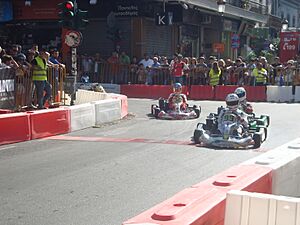
Patras has many sports facilities and important teams. Panachaiki Gymnastiki Enosi, Apollon Patras, E.A. Patras, and NO Patras are major sports clubs. They play football, basketball, volleyball, and water polo. The city's national stadium, Pampeloponnisiako Stadium, was updated in 2004. Since 2009, the Patras International Circuit Kart event turns city streets into a race track.
Patras has hosted many international sports events. These include basketball, volleyball, gymnastics, wrestling, and football tournaments.
| Club | Sport | Current League | Venue | Location | Capacity | Established | Highest ranking |
|---|---|---|---|---|---|---|---|
| Panachaiki G.E. | Football | Super League 2 | Kostas Davourlis Stadium | Agyia | 11,321 | 1891 | 4th (1973) |
| Volleyball | Volleyball League | Panachaiki Indoor Arena | 500 | 1928 | 8th (2016) | ||
| Apollon Patras | Basketball | Basket League | Apollon Patras Indoor Hall | Perivola | 3,500 | 1926 | 6th (1986) |
| E.A. Patras | Volleyball | A2 Ethniki | EAP Indoor Hall | Agios Dionysios | 2,200 | 1927 | Champion (1938) |
| NO Patras | Water polo | A1 Ethniki | NOP Aquatic Centre | Akti Dymeon | 3,000 | 1929 | Champion (x 8) |
| Thyella | Football | Delta Ethniki | Fotis Aravantinos Stadium | Glafkos | 3,000 | 1930 | 5th (B Ethniki) |
| Olympiada Patras | Basketball Volleyball |
A2 League A2 Ethniki |
Olympiada Indoor Hall | Taraboura | 2,500 | 1961 | 8th (2002) 10th (2007) |
| Promitheas Patras | Basketball | Basket League | Dimitris Tofalos Arena | Bozaitika | 4,500 | 1985 | 2nd (2019) |
| Ormi Patras | Handball | A1 Women's | National Indoor Hall | Koukouli | 1,000 | 2003 | Champion (x 6) |
| NE Patras | Water polo | A2 Ethniki A1 Women's |
Antonis Pepanos Aquatic Centre | Koukouli | 4,000 | 2006 | 4th (2009) 4th (x 3) |
Religion in Patras
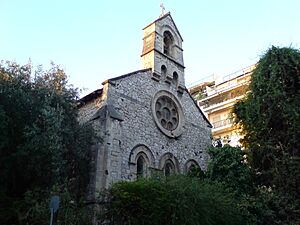
The main religion in Patras, like most of Greece, is Greek Orthodox. There is also a community of Roman Catholics and an Anglican church.
The most important church is the Orthodox Cathedral Church of Saint Andrew. It started being built in 1908 and opened in 1974. It's the largest church in Greece. It holds relics of Andrew the Apostle, which were returned from Rome in 1964.
Other historic churches include:
- The church of Pantokrator (1832), the old cathedral.
- The Metropolitan Church of Patras (1846).
- The church of Ayios Nikolaos (1885).
- The Catholic Church of Saint Andrew (1937).
- The Anglican church of Saint Andrew (1878).
- The old church of Ayios Andreas (1836–1843).
- Girokomiou Monastery: A historic monastery founded in the 10th century AD.
- Monastery of Agios Nikolaos Bala: Built at the foot of Panachaikos mountain.
The patron saint of Patras is Saint Andrew the Apostle.
Local Flavors: Patras Cuisine
Some local food and drink specialties include:
- Bourjeto (a fish dish)
- Tilichtária Patrina (a pork meat dish)
- Galatopita (a milk pie)
- Tiganites (a type of pancakes)
- Patrina loukoumia (a sweet treat)
- Rodozachari (a rose-flavored sweet)
- Mavrodafni wine
- Tentura drink (a liqueur)
Getting Around Patras: Transport Links
Sea Travel: The Port of Patras
Patras has always been a key sea-trade center. Its port handles more than half of Greece's international sea passengers. It has great ferry connections to the Ionian islands and major Italian ports. A new port was built in the south of the city. This helps with more traffic and frees up the city center. Ferries to Italy now use this new port.
Roads: Driving in and Around Patras
A new 20-kilometer (12-mile) ring road (the Bypass of Patras) opened in 2002. It helps reduce heavy traffic in the city. A smaller "Mini bypass" was finished in 2019. It connects the northern and eastern parts of the city, making it faster to cross downtown.
The highway to Athens was recently improved. It's now a 220-kilometer (137-mile) highway. The trip to Athens takes about 1 hour and 45 minutes. Patras will also be a central point for the Ionia Odos highway. This highway will connect western Greece from Kalamata to Ioannina. The Rio-Antirio bridge links the Peloponnese to mainland Greece.
Rail: Train Services
A simple single, narrow gauge railway line crosses the city. It connects Patras to Rio. In the past, trains connected Patras to Athens and other cities. Today, only suburban trains use the track. They connect Patras with nearby villages like Rio and Agios Vasileios.
A new standard gauge railway line is being built. It will link Patras to Korinth and Athens. Construction is ongoing near Patras' suburbs.
Public Transport: Buses and Local Trains
Patras has a bus system. There are lines to the University of Patras and to city suburbs. Commuter rail services have started with Proastiakos. One line connects Patras, Rio, and Agios Vasileios. Regional bus services connect Patras to most of Greece.
Air Travel: Patras Airport
Seasonal flights are available from the military Patras Araxos Airport. It's about 40 kilometers (25 miles) from the city center.
Patras and the World: International Connections
Patras is a "pilot city" for the Council of Europe and the European Commission's Intercultural Cities program.
Twin Towns and Sister Cities
Patras is twinned with many cities around the world. This means they have special friendly relationships. Some of these cities include:
- Aleksinac, Serbia
- Banja Luka, Bosnia-Herzegovina
- Ancona, Italy
- Bari, Italy
- Byblos, Lebanon
- Bydgoszcz, Poland
- Canterbury, Australia
- Chişinău, Moldova
- Craiova, Romania
- Debrecen, Hungary
- Famagusta, Cyprus
- Focşani, Romania
- Gjirokastër, Albania
- Kharkiv, Ukraine
- Limassol, Cyprus
- Ohrid, North Macedonia
- Reggio Calabria, Italy
- Saint-Étienne, France
- Savannah, US
- Split, Croatia
- Vilnius, Lithuania
- Wuxi, People's Republic of China
- Kaliningrad, Russia
In 2006, Patras was featured on a special €10 Greek coin. This coin celebrated Patras being the European Capital of Culture.
Images for kids
-
The flag raised by Andreas Londos in Patras at the start of the Greek War of Independence.
-
Inside the Mycenaean cemetery of Voudeni, outside the city
-
Athanasios Kanakaris during the Siege of Patras by Peter von Hess (1821)
-
Alhambra mansion, Trion Navarchon Street
-
The house where Kostis Palamas and Matilde Serao were born.
See also
 In Spanish: Patras para niños
In Spanish: Patras para niños




